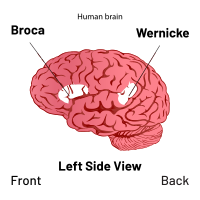
Photo from wikipedia
PURPOSE To describe language-based neuropsychological outcomes following brain injury in two pediatric populations commonly treated in rehabilitation settings, namely severe traumatic brain injury (sTBI) and stroke secondary to arteriovenous malformation… Click to show full abstract
PURPOSE To describe language-based neuropsychological outcomes following brain injury in two pediatric populations commonly treated in rehabilitation settings, namely severe traumatic brain injury (sTBI) and stroke secondary to arteriovenous malformation (AVM). METHODS Investigated were children between the ages of 6 and 16 who were admitted to a brain injury rehabilitation program in a pediatric rehabilitation hospital and who were diagnosed with a left-sided sTBI (n= 16; mean age = 13.2) or a left-hemispheric stroke secondary to AVM (n= 16, mean age = 10.7). Groups were compared on demographic information, as well as general cognitive and language-based neuropsychological measures, controlling for age. RESULTS Children in the AVM group presented with greater deficits, at trend levels, relative to the sTBI group on measures of working memory, verbal fluency, and an aphasia screening tool. CONCLUSIONS This study represents an initial step in understanding the language-based neuropsychological outcomes of children diagnosed with sTBI compared to those with stroke secondary to AVM, which will help inform the rehabilitation process. With this knowledge, clinicians, families, and educators will be better equipped to provide informed individual rehabilitation programs, recommendations, and education for children and adolescents with brain injuries.
Journal Title: Journal of pediatric rehabilitation medicine
Year Published: 2018
Link to full text (if available)
Share on Social Media: Sign Up to like & get
recommendations!